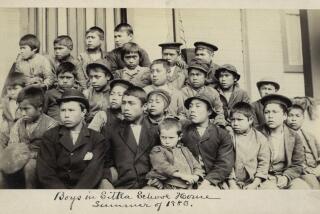Review: Timothy Egan’s insightful ‘Short Nights of the Shadow Catcher’
Short Nights of the Shadow Catcher
The Epic Life and Immortal Photographs of Edward Curtis
Timothy Egan
Houghton Mifflin Harcourt: 384 pp., $28
Edward Curtis was given many names by the native peoples he encountered in his journeys across the North American continent.
The Sioux named him for a rock formation, “Pretty Butte.” The Hopi saw him sleep on an air mattress and called him “The Man Who Sleeps on His Breath.” And the Navajo gave him the moniker that was perhaps most apropos to his profession: “Shadow Catcher.”
Curtis trapped shadows and light in his box cameras. A century after he opened the shutter of his camera on wind-swept prairies and frozen islands, his enduring photographs define the dignity of the Native American experience — and the great crime of the cultural genocide inflicted upon them.
A man with limited education but limitless ambition, Curtis eventually completed one of the greatest book projects in American history. This unlikely career is the subject of Timothy Egan’s insightful and entertaining new book, “Short Nights of the Shadow Catcher: The Epic Life and Immortal Photographs of Edward Curtis.”
Curtis had no formal training as a photographer — his first camera was one he built himself from a castoff lens that survived the Civil War. But if you open a U.S. history textbook, you’ll probably see one of his images.
“He was shooting contemporary photographs,” Egan writes, “but the pictures looked like historical documents even before he developed them.”
His portraits, especially, have a timeless quality. There is his 1905 portrait of the great Apache fighter Geronimo, with his weathered face. And his photograph of the tragically regal Chief Joseph of the Nez Perce, covered in shell necklaces just months before a death his doctor attributed to “a broken heart.”
The man behind these images was the son of a humble Minnesota family who resettled in Seattle during that city’s late-19th century transformation from frontier town to Western metropolis.
In and near Seattle, Curtis literally earned his living from the muck: digging for clams and doing other menial jobs. From a traveler headed to Alaska’s gold fields, he bought a 14-by-17-inch view camera.
Curtis set up a photo studio. It soon became clear he had “the eye,” and within four years he was Seattle’s most renowned photographer, shooting portraits of its wealthiest citizens.
Then he decided to photograph the impoverished woman famous locally as the last surviving child of Chief Seattle. “Princess Angeline” was then 100 years old. Or perhaps 80. No one knew for certain. Curtis worked days to capture the portrait he wanted, an encounter between photographer and subject that Egan describes with his own patience and skill.
“He was looking for the lethal glare she saved for the boys who threw rocks at her,” Egan writes. “He hoped to convey a face that had seen worlds change, forests leveled, tidelands filled, people crushed.”
Curtis got his picture. Angeline was dead within months. Obsessed with the idea that the Indian people of the Pacific Northwest would soon follow her into extinction, Curtis began traveling to nearby native communities to preserve something of them for history.
It wasn’t easy for a white man to make people who had been victimized by white people feel comfortable in his presence. But Curtis pulled off this feat again and again.
“His Indians were a startling departure from the usual depictions of these people,” Egan writes. “There were, in the faces, distinct human beings, not character types.”
Curtis latched on to the idea that he should undertake his own grand project — to photograph every Native American nation on the continent before they disappeared. Doing such a project right required a lot of money. Curtis estimated he would need $70,000 over five years. He asked one of the wealthiest men on the planet for this huge sum — J.P. Morgan, the financier whose railroads crisscrossed Indian lands and helped accelerate the decline of their cultures.
“I like a man who attempts the impossible,” Morgan told him.
Curtis worked as an ethnographer would, learning about the rituals and beliefs of each nation he visited. He might spend years returning to a reservation again and again, until he was finally granted access to sacred ceremonies, such as the Snake Dance of the Hopi. The result was a work that smashed a hateful misconception about Native Americans: that they were “godless” peoples without religious beliefs.
In the introduction to the first volume, Curtis described Native Americans as at one with “the phenomena of the universe — the trees and shrubs, the sun and stars, the lightning and rain.”
“There is scarcely an act in the Indian’s life that does not involve some ceremonial performance or is not itself a religious act,” he wrote. In 1910, these were radical ideas for a white man to put forward.
In the end, the project took 30 years instead of five, as Curtis traveled back and forth across the U.S. some 122 times. He captured Native American life as it was, amid vast and remote landscapes, and he developed an aesthetic that influenced John Ford, Ansel Adams and many other artists.
The work, and the passion Curtis put into it, ruined his body and his marriage and left him broke. But he finished what he had proposed to Morgan: 20 volumes with 2,200 original photographs and 4,000 pages of text.
Curtis’ achievement was to meld compassion with great vision, but his work was largely forgotten by the time he died in Los Angeles in 1952.
Now Egan’s excellent book stands as a fitting tribute to an American original who fought for a people with his camera and his art.
More to Read
Sign up for our Book Club newsletter
Get the latest news, events and more from the Los Angeles Times Book Club, and help us get L.A. reading and talking.
You may occasionally receive promotional content from the Los Angeles Times.







